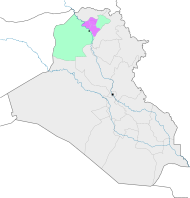Shibaniba
Shibaniba | |
 Shown within Iraq | |
| Location | Nineveh Province, Iraq |
|---|---|
| Region | Northern Mesopotamia |
| Coordinates | 36°25′55″N 43°17′56″E / 36.43194°N 43.29889°ECoordinates: 36°25′55″N 43°17′56″E / 36.43194°N 43.29889°E |
| Type | tell |
| Site notes | |
| Excavation dates | 1850, 1930–1934 |
| Archaeologists | A.H. Layard, E.A. Speiser, C. Bache |
Tell Billa is an archaeological site near Bashiqa in Nineveh Province (Iraq). It is the ancient city of Shibaniba, not far from Assur. The name Shibaniba comes from the Middle Assyrian sources.
History of archaeological research[]
After some minor soundings done by Austen Henry Layard around 1850, Tell Billa was excavated between 1930 and 1934 by a team from the University of Pennsylvania and the American Schools of Oriental Research. The excavation was led by Ephraim Avigdor Speiser with Charles Bache.[1][2][3][4][5][6] The work was complicated by the fact that the mound was divided up among 18 owners including a Jacobite church.[7]
At the same time, these scholars explored the related nearby ancient site of Tepe Gawra, which is located about 8 km (5.0 mi) northeast of Billa.[8]
Tell Billa and its environment[]
The site consists of a large mound and covers around 30 acres (12 ha).
Occupation history[]
There is some evidence of occupation as far back as the Uruk period, including some Hurrian presence in the middle second millennium. The majority of excavated material, however, is from the Middle Assyrian and Neo-Assyrian times, including glyptic and epigraphic material. 91 Middle Assyrian tablets (ca. 1400-1000 BC) are attested from Tell Billa/Shibaniba.[9] The name Shibaniba relates to this period of its history.
The Hurrian artifacts were identified in the excavators' Stratum 3.[10] The comparison with the similar artefacts from Nuzi led Speiser to conclude that the Hurrians settled at Billa before they moved on to Nuzi,
- “Billa was apparently settled by the Hurrians several generations earlier than Nuzi ...”[11]
The lack of inscribed documents at Billa, as opposed to Nuzi, further supported his conclusion.
See also[]
- Cities of the ancient Near East
References[]
- ^ The Expedition to Tell Billa and Tepe Gawra, Bulletin of the University Museum, University of Pennsylvania, vol. 3(2), pp. 59-66, 1931
- ^ Developments at Tell Billa and Tepe Gawra, Bulletin of the University Museum, University of Pennsylvania, vol. 3(3/4), pp. 94-95, 1932
- ^ Excavations at Tell Billa and Tepe Gawra, Bulletin of the University Museum, University of Pennsylvania, vol. 3(5), pp. 126-130, 1932
- ^ E. A. Speiser, The Bearing of the Excavations at Tell Billa and at Tepe Gawra upon the Ethnic Problems of Ancient Mesopotamia, American Journal of Archaeology, vol. XXXVI, pp. 29-35, 1932
- ^ Charles Bache, Work of the Baghdad School, Bulletin of the American Schools of Oriental Research, no. 51 , pp. 20-26, 1933
- ^ Charles Bache, From Mr. Bache's First Report on the Joint Excavations at Tepe Gawra and Tell Billah, 1932-3, Bulletin of the American Schools of Oriental Research, no. 49, pp. 8-14, 1933
- ^ University of Pennsylvania Museum - Baghdad School Expedition at Billah (letter from E. A. Speiser), Bulletin of the American Schools of Oriental Research, no. 40, pp. 11-14, 1930
- ^ Excavations at Tell Billa and Tepe Gawra, Bulletin of the University Museum, University of Pennsylvania, vol. 3(5), pp. 126-130, 1932
- ^ Digital Tell Billa tablets at CDLI
- ^ Speiser, E. A.. "The Pottery of Tell Billa." The Museum Journal XXIII, no. 3 (September, 1933): 249-308. Accessed November 07, 2021
- ^ Speiser, E. A.. "The Pottery of Tell Billa." The Museum Journal XXIII, no. 3 (September, 1933): 249-308. Accessed November 07, 2021
Further reading[]
- C. L. Wooley and E.A. Speiser, Excavations at Ur;the Pottery of Tell Billa, The Museum Journal, vol. 23, no. 3, pp. 249–308, 1933
- Jacob J. Finkelstein, Cuneiform Texts from Tell Billa, Journal of Cuneiform Studies, vol. 7, pp. 111–176, 1953
- Claudio Saporetti, Middle Assyrian Texts of Tell Billa (Graphemic Categorization, No 3), Undena Publications, 1990, ISBN 0-89003-159-2
- Speiser, E. A., Gleanings from the Tell Billa texts, Symbolae ad iura orientis antiqui pertinentes Paolo Koschaker dedicatae, Leiden, Brill, pp. 141–50, 1939
- Donald Matthews, Middle Assyrian Glyptic from Tell Billa, IRAQ, vol. 53, pp. 17-42, 1991
External links[]
- Digitizing Tell Billa - work on publishing 1930s digs
- Expedition video from the University of Pennsylvania Museum 4
- Expedition video from the University of Pennsylvania Museum 3
- Expedition video from the University of Pennsylvania Museum 2
- 3rd Millennium BC cylinder seal from Tell Billa - possibly lost
- Archaeological site photographs from the Oriental Institute
- Digital Tell Billa tablets at CDLI
- Tells (archaeology)
- Archaeological sites in Iraq
- Former populated places in Iraq
- Nineveh Governorate
